#african grey bonding
Text
#tiktokparrot#african grey#african grey parrot#african grey behavior#african grey parrot care#african grey parrot lifespan in captivity#africangrey#african grey lifespan#buying an african grey parrot#cute birds#African Grey adoption considerations#African Grey aggression#African Grey avian enrichment#african grey behavior problems#african grey bonding#African Grey boredom busters#african grey care#african grey care guide#african grey communication#African Grey companion bird#African Grey conversation#African Grey depression#African Grey emotional wellbeing#African Grey enrichment activities#African Grey enrichment ideas#African Grey excessive screaming#African grey exercise#African Grey feather plucking causes#african grey foraging toys#African Grey happy home
0 notes
Text
I present yet ANOTHER atsv au:
the bird companion au
in which at the age of 10, every person is given a bird companion that signifies their purpose, character, and destiny by the Canon itself in a large ceremony.
Miles Morales was given the companion of a cockatiel, Gwen Stacy was given the companion of a swan, Pavitr Prabhakar was given the companion of a bluebird, and Hobie Brown was given the companion of a cockatoo.
Miguel O’Hara was given the companion of an African Grey Parrot, Jessica Drew was given the companion of a bald eagle, and Peter B. Parker was given the companion of a pigeon (hear me out here).
All of these symbolize their character and even their role in the multiverse. Cockatiels (Miles’s bird) symbolize the important of socialization and creating bonds with others, as well as holding your loved ones dear to your heart. Swans (Gwen’s bird) symbolizes grace and beauty. The swan is also seen in the famous ballet Swan Lake and it deals with the character of Odette being cursed, which is similar to Gwen Stacy and her curse of dying in every other universe.
Bluebirds (Pavitr’s bird) represent joy, happiness, and harmony, which is similar to how in the face of disaster and dangerous threats, Pavitr is still able to shine through with unwavering optimism that doesn’t feel faked in the slightest. Cockatoos (Hobie’s bird) don’t have one definite symbolism, but they are known for their seed dispersal to help regenerate the forest, and are often seen as “pests” to most farms. This can reflect on how Hobie gives to the community while screwing over the authority that wants to keep all resources to themselves.
African Grey Parrots (Miguel’s bird) are regarded as one of the smartest birds in the world, being the smartest parrot in the world as well. This, along with them symbolizing royalty through its tail feathers, emphasizes on the isolation Miguel goes through with his unique knowledge on the multiverse and the consequences of meddling with the Canon, as well as the grief and guilt that comes with knowing what will happen in the future.
Bald eagles (Jess’s bird) are seen as symbols of bravery and strength, which Jess perfectly represents. She works in one of the most elite and strict societies with prestige and a sense of professionalism that no one can deny is present. Yes, while this bird is also seen as specifically a symbol for the United States of America, this is what they symbolize on a broader level.
Now you may think I did Peter dirty by giving him a freaking PIGEON but the symbolism behind this particular bird fits his character arc a lot. Pigeons are seen as symbols of peace, love, and tranquility (calmness). His arc of learning to being love (MJ) back into his life again and a sense of peace with his new family emulates this bird perfectly. Also, I just see him with a pigeon especially with his attire, okay?
Here’s one more snippet for my OC Mariano O’Hara from the Mariano O’Hara au hehe
—-
Mariano O’Hara, if he were in this au as well, would be given the companion of a mockingbird. Mockingbirds, especially in the novel To Kill a Mockingbird, are symbols of innocence. To kill a mockingbird then, is to destroy innocence. Mariano, while he does have some of the qualities of getting a cockatiel, bluebird, and even a pigeon, he gets a mockingbird because his innocence of the world highlights everything else in his personality. His abundant kindness and love for the world is a direct result of being kept away from it by Miguel, who is extremely adamant on making sure he doesn’t face the horrors of society that are unfortunately present. They parallel each other in a way: Miguel’s bird represents the burden of having the most knowledge and intelligence out of anyone and Mariano’s bird shows both the ups and downs of being completely innocent, by being both ignorant of everything bad, but also vulnerable to those evil forces.
—-
So you can tell I have a lil obsession hehe
lemme know what you guys think and add your own thoughts to this!!!
taglist: @adorefavv @chessbox @daydreaming-en-pointe @darksidescorner @hoe-bie @hobiebrownismygod @i-put-the-wit-in-dimwit @ace-and-sleepdeprived @jasontoddssuper @skullghoulz @sp1derw1re @spiderxpawz @thecrowandtherose @the-cat-and-the-birdie
#atsv#spiderman atsv#spiderman across the spiderverse#atsv miguel#miguel o hara#miguel spiderman#across the spider verse#miguel ohara#miguel spiderverse#miguel o'hara#across the spiderverse#miguel o’hara across the spider verse#spiderman across the verse#hobie brown#hobart brown#atsv hobie#hobie atsv#spider punk#miles morales#atsv miles#miles atsv#pavitr prabhakar#atsv pavitr#pavitr atsv#gwen stacy#atsv gwen#gwen atsv#spiderman#peter b parker#atsv peter b parker
42 notes
·
View notes
Text
Tf2 Mercs as Birds (Mostly parrots)
Scout:

Scout would be a budgie! They’re really small and constantly zoom around with energy. They literally never stop going.
Soldier:

Soldier would be a bald eagle. This pretty much speaks for itself.
Pyro:

Pyro would be a cockatiel! They are known to be very sweet birds to the people they’ve bonded with, but they can also go absolutely nuts at the drop of a hat. They’re also known for their fiery red cheek circles! They are capable of mimicking human speech, but the words they’re saying can be difficult to make out unless you’re the one who taught the phrase. They’re also my favorite bird akdjidebieeheh
Demo:

Demo would be a macaw! They have large personalities and are very strong physically. They are also very sweet to the person they’ve bonded with. Not to mention that macaws are the pirate birds! Macaws are iconic as hell!!
Heavy:

Heavy would be a Hyacinth Macaw! This species of parrot is the largest in the world. They have massive beaks capable of destruction! However, they are considered to be very gentle despite their size.
Engie:

Engie would be an African Grey! Greys are considered to be one of the smartest parrot species and the most capable of mimicking human speech. They also tend to be pretty calm and low key compared to other large parrots. Idk they’re just really smart and really polite🥺
Medic:

Medic would be an umbrella cockatoo. They’re one of the smartest parrots, but more importantly, they are ALL FUCKING INSANE. They love screaming gibberish and whipping their heads around while screaming said gibberish. But! They are EXTREMELY sweet and clingy with their chosen person.
Sniper:

Sniper would be a wedge-tailed eagle! They’re native to Australia and have some of the best eyesight out of any species on earth. They are also solitary compared to other birds, who live in flocks usually.
Spy:
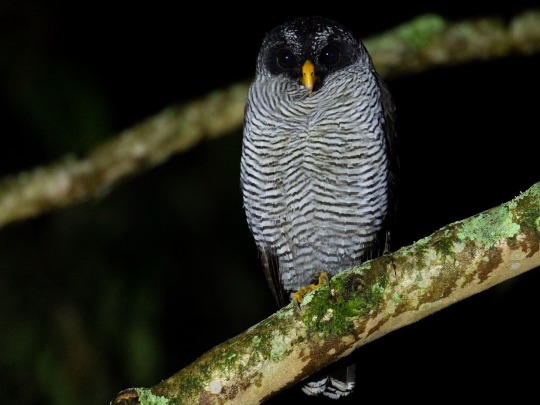
Spy would be a black banded owl. Owls have feathers that are specially designed to allow the bird to fly in complete silence. Its prey never sees it coming from behind until it’s too late! They’re also solitary birds that prefer to work alone unless they’re with a mate.
#tf2#tf2 headcanons#tf2 hcs#tf2 imagines#tf2 imagine#tf2 scout#tf2 pyro#tf2 soldier#tf2 demoman#tf2 heavy#tf2 engineer#tf2 medic#tf2 sniper#tf2 spy#BIRD HYPERFIXATION#vaguely bird shaped object#parrots#team fortress 2#team fortress 2 imagines
329 notes
·
View notes
Text
The animal experiments
Warning mentions of waste
The animal experiments were conducted to see how Dr. J. Clementine would fare in a non-human host. Given the nature of 963 and the previous experiments it was completely unknown. A few hypotheses have been suggested.
•That he would start changing the appearance of the animal.
•That the hosts would grow certain parts to be able to do human tasks.
•That he would bond completely other than certain anatomy. Specifically cat ears and a cat tail.
[22/05/■■■■]
A stray tabby cat was gathered from a rescue shelter. It was a chubby grey tabby.
After one death a quick reminder to junior researchers that SCP 963 isn’t to be touched without gloves, SCP 963 was fastened onto a collar.

[image taken 22/05/■■■■] 1145
Around 1232 tufts of fur had been spotted around the parts of the facility that Dr. Clementine had been allowed to access. Dr. Clementine had been napping in front of a window, taking in the noon sun. The tufts of fur was shedding from the scar forming.
After calling to him by name he reacted immediately. He was able to recognize his name, as well as Dr. ■■■■■, who he is close to. After a few tests it was determined that Dr. Clementine was able to recognize certain people, places, and a toy slug. Even though the intelligence is heightened, it is still that of a cat.
[23/05/■■■■]
After Dr. Clementine was released from the kennel he was sleeping in, Clementine immediately had back away and hissed at the personal that had released him.
After a ton of scratching he allowed someone to pick him up. Though he was growling the whole trip.
Only placing kibble on the table kept him still long enough to take an x-ray and examination. Both revealed nothing out of the ordinary. No changes in bone, skin or fur. The cat was perfectly healthy.
[25/05/■■■■]
Bonding continued to not occur. The only change that happened was his tooth going missing after he bit Dr. ■■■■ because he didn’t hold him correctly. Which would be like an infant.
He was brought to SCP 529, to see how he would react with another feline. The two greeted each by sniffing. Though Dr. Clementine was weary of Joises lack of a bottom half, the two grew close with an exchange of slow blinks.
When all human entities had left the cell, it had been monitored that the two cats were ‘loafing’ beside each other, with SCP 529 occasionally rubbing her head along Jacks side.
[01/06/■■■■]
SCP 963 was removed from the cat and the body was quickly discarded.
[01/06/■■■■]
The chain of SCP 963 was looped around rope, and tied around the neck of an American Landrace Pig.

[image taken 01/06/■■■■] 1526
[02/06/■■■■]
At 0245 it was discovered where Dr. Clementine had found reasonable to defecate, unfortunately it was in front of the break room with the vending machine with the good snacks. He absolutely refuses to use the bathroom anywhere but that doorway.
It was decided to give Dr. Clementine entertainment to stop him from bothering the researchers. He was given a football and straw tubes.
[03/06/■■■■]
Dr. Clementine was permitted to wander around more of the facility, so D-class could remove the smell from the break room.
He found himself in front of the cell of SCP 321. He plopped himself down in front of the door for 2 hours, every few minutes he would push his ball up to the door as if the anomaly was able to come outside and play with him.
An agent tried to move him away, but Dr. Clementine nudged him with his head. When it didn’t move the agent he bit onto his pants and refused to release them.
Eventually he made his way back to the break room.
[06/06/■■■■]
Multiple puzzles were set in front of Dr. Clementine, which he was able to pass for treats. Including, a maze, opening crates, and matching shapes and colours. However he wasn’t able to do more difficult puzzles, even for snacks and toys.

[09/06/■■■■]
A female African grey parrot was gifted to the foundation and to be Dr. Clementines next host. It was hoped that he would be able to mimic human speech, but it was unsure if he would be able to actually understand it.
[image removed]
Dr. Clementine was permitted to be in most social areas to encourage speech. He is allowed to be in the cafeteria, break rooms, and certain researchers office.
Dr. Clementine struggled to fly for the first few hours but soon was found playing in the rafters.
[10/06/■■■■]
Dr. Clementine went into Dr. Clefs office at 1033, and at 1254 he had learned the words, “piss-fuck” “𝄡” “cocaine” “I’m a silly goose”. It is most likely that Clef is purposely teaching him these things. It should be noted that it was said in Dr. Clementines voice rather than Dr. Clefs.
[12/06/■■■■]
Dr. Clementine had a much better grasp on the English language. He was able to label things in his surroundings, flying to them and saying what they are. Examples would be
•if someone knocked on a desk, he would knock on it with his beak and say “wood”
Or
•going to the rafters and saying “metal”
He is much faster at learning speech and better at pronouncing words than what was expected.
[15/06/■■■■]
When Dr. Clementines handler passed his office, Dr. Clementine flew over and hovered around the door repeatedly saying “Haold” and “cikly”or other variants.
[15/06/■■■■]
The corn snake that had nearly finished shedding its skin was brought in.
Attaching SCP 963 on to such a tiny animal was over looked until now. SCP 963 being attached to a harness with the amulet on a wagon. The Dr. Clementine gain consciousness he began to freak out. This included wrapping around Dr.■■■■ wrist and biting him. Thrashing violently, he calmed down when a camera was brought out. He began flicking his tongue at it.
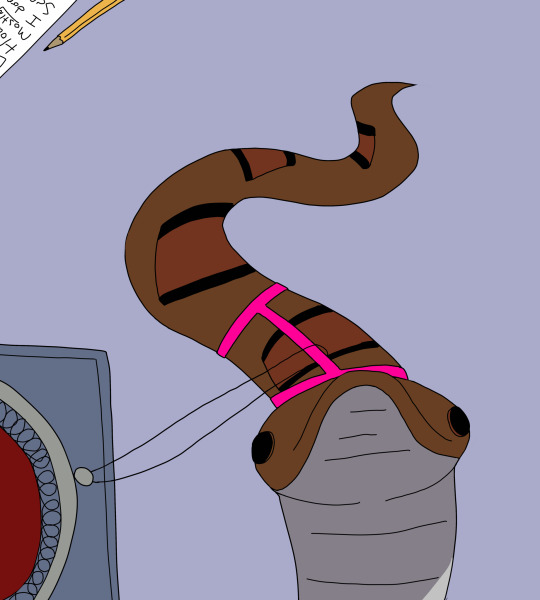
[15/06/■■■■] 0924
After being placed in a glass enclosure it was evident that Dr. Clementine wasn’t able to climb anything due to the weight of SCP 963.
[19/06/■■■■]
Dr. Clementines eyes had finally turned green after the eye caps came off, and his scales had much more of an orange tint.
[20/06/■■■■]
Dr. Clementine had started attacking SCP 963 in annoyance and flinching away in pain.
[23/06/■■■■]
A doe was found a couple hundred yards away from site 19. It was brought in.
SCP 963 was put back on its original chain and hung around the deers neck.
Image removed
Dr. Clementine struggled to walk, and his front legs kept repeatedly buckling over. He was followed as he explored to ensure that he wouldn’t injure himself.
[25/06/■■■■]
Dr. Clef was permitted to bring Dr. Clementine to SCP 166s temporary contaminant cell. SCP 166 and Dr. Clementine allegedly were timid of each other at first, but did warm up after a few minutes. Once Dr. Clementine recognized who SCP 166 was he began to lick the top of her head.
SCP 166 had made a flower crown made from the yellow roses that were loose in her antlers. Dr. Clementine responded with a behaviour that wasn’t common with deer, by wagging his tail and stomping the floor repeatedly. A very human reaction to excitement.
[27/06/■■■■]
A few staff members have brung Dr. Clementine apples, and other fruits/veggies. Though most chased him away from them still angry about the break room.
At 1644 Dr. Clementine had been found halfway out of a window. He would try to kick any presences he could feel behind him.
The second his limbs hit the floor he bolted around randomly, trying to get away from staff.
He wound up at a dead end, crashing against the wall and was unable to get back up. He kicked at nothing with his back hoof repeatedly in a pattern. It was matched with flinching and uneasy breathing.
An apple was offered to Dr. Clementine. He instantly shoved his nose against it as if it would rot at any second. He attempted to get the apple back to his safety wall, but couldn’t because of his leg.

The now wilting rose crown was slid over to him. He placed the apple inside of the flower ring. He kneeled in front of it and watched staff intently.
By this time most who gathered around had left due to lack of interest.
[29/06/■■■■]
■■■■■■■■■■■■■■■■. A stray greyhound with a cut in his ear. ■■■■■■■■■■■■ ■■■■■■■■■■■■■■■■■■■■. ■■■■■■■■.
Image removed
[01/07/■■■■]
Dr. Clementine was very friendly with staff. A bit too friendly. If not actively being held back he would run up to them and happily yap, while wagging his tail. He’d tries to sit his entire body on people’s feet.
[02/07/■■■■]
At 1752 Dr. Clementine was found trying to bite the wall, growling viciously. His mouth unable to wrap the smooth surface.
Dr. Clementine was snatched up by the back of the collar, and yanked away from the wall. Dr. Clementine lashed out, YAP YAP YAP! He just wanted to get back to his tasty wall.
[05/07/■■■■]
Dr. Clementine was sat in front of a window, barking at everything that moved, taking in the sun rays. Upon hearing a whistle, Dr. Clementine swerved his head around, tongue sticking out. He walked up to the source of the noise. Little feet paddling and tail wagging.
The researcher brought him to his next host.
[06/07/■■■■]
A wild Guinea pig sat on the metal table. Given the size of the critter, it was decided to just tie it around their back.
[07/07/■■■■]
The moment Dr. Clementine saw SCP 590s cell he began weeking. Loud peeps emanated from the small carrying cage.
Once staff entered they were greeted by SCP 590, who was excited to see the rodent. “That is Dr. Clementine.” Was said as the cage was placed onto the desk near his bed.
SCP 590 leapt over to the cage. SCP 590 tried to pick up Dr. Clementine with his bare hand. Which made Dr. Clementine jolt to the other side of the cage. When SCP 590 picked up Dr. Clementine with his prosthetic hand, Dr. Clementine allowed him. He tucked his hands and feet under his body and laid flat.
[08/07/■■■■]
Dr. Clementine was removed when SCP 590 was still sleeping.
Throughout the day Dr.Clementine seemed to be depressed.
[11/07/■■■■]
Dr. Clementine was found tearing at his scar. Not to the point where he was causing damage but he seemed to be trying to rip it off of his body.
Dr. Clementine would squeal angrily, only to calm whenever SCP 590 spoke, even if he didn’t understand what he was saying.
[13/07/■■■■]
A yellow moray eel squirmed as it was hung above the tank. A tempered glass collar was slid around her neck, with SCP 963 inside of it.
The eel was dropped back into the cage. Though it took a couple of moments for Dr. Clementine to figure out how to swim. He eventually noodled around, snapping his jaw.
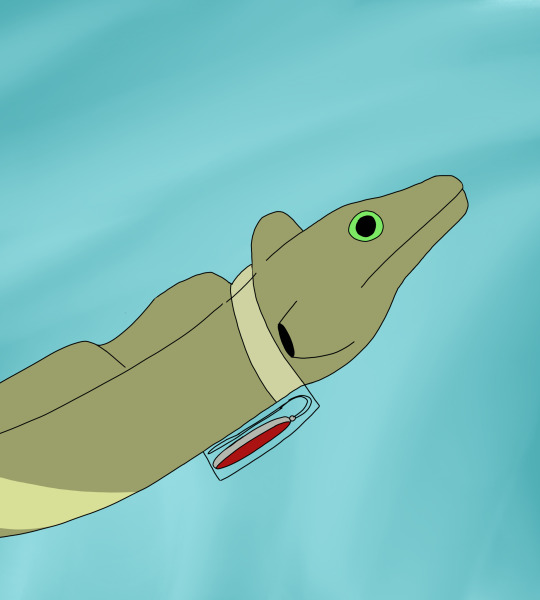
[14/07/■■■■]
FUCK FUCK FUCK FUCK HE GOT OUT HOLY FUCK HOW JUESUS FUCK ME UNTIL I DIE THEN KEEP GOING HOLY SHIT FUCK FUCKING HOW!?!?!?!?!!?
[03/08/■■■■]
Dr. Clementine somehow was in the Gulf of Mexico. He was drifting happily through a small crevasse in a ledge. He got several new scars swirling his body. In order to safely get him out pets and treats were offered.
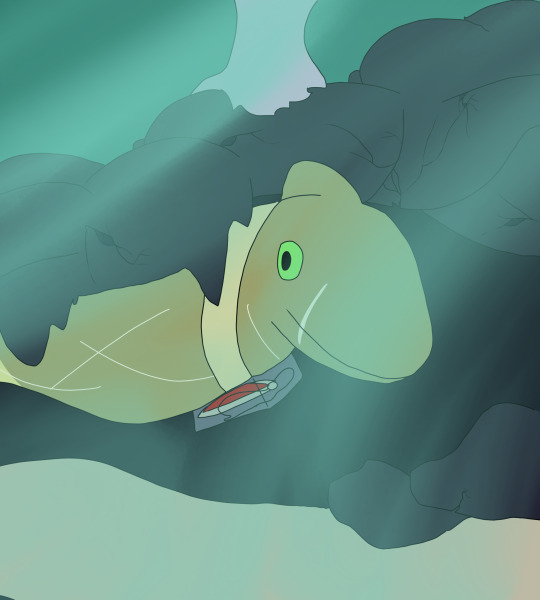
Ending notes:
•Dr. Clementine has no memories being in a non-human host
•being in non-human hosts changed his psyche, he sometimes acts like an animal (ex:loafing, whistling, playing in the rafters, barking, crawling on all fours, ect.)
•Dr. Clementine has no idea he acts like an animal
#it’s not supposed to be accurate it’s supposed to be fun#let me be cring and silly#am a little self conscious •~•#im sorry the squares look weird#2/3 experiments done#jack clementine#dr jack clementine#dr clementine#scp 963#dr. clementine#bright rewrite#whaaa#so scared to post#I tried to make them happier
8 notes
·
View notes
Text
daemon roundup: wolves
i've been wanting to do a write-up on wolf daemon forms for a while now as i think they're a popular form and the phylogenetic distinction between the grey wolf and all of its subtypes is fascinating. species outside of the grey wolf are often considered nonviable due to their overlap with the grey wolf but also the difficulty researching their ecology. so here is going to be my deep dive on the wolf daemon persona overall, as well as what canis lupus subspecies (as well as peripheral species of the african wolf, eastern wolf, and red wolf) can be considered viable forms.
the wolf personality overall
subspecies aside, all wolf daemon individuals are going to share some essential traits.
— loyal and cooperative. canis lupus forms, both the wild wolf and domestic dog, are notorious for their sense of community and hierarchy. wolves depend on the group for survival; social dynamics among the pack are incredibly complex, reinforcing tight-knit bonds and a democratic hierarchy among the family unit. wolves play, console each other, and develop unique pack culture through intergenerational communication. while sociability and extroversion varies between subspecies, all people with wolf daemons are going to naturally form or desire close friendships, and they are committed and generous to the ones they love.
— communicative and tactful. similar to above, wolf individuals are very honest and expressive. wolves have very advanced communication that include vocalizations, body language, and scent marking. this enables them to diffuse conflict and reinforce hierarchy, maintaining stability in the pack. while inter-pack aggression isn't rare, territories are defined through olfactory signaling and vocalizations. those with wolf daemons therefore prioritize clearly expressing themselves and their boundaries. they are socially intuitive and value group harmony; it is important for them to know where they stand and that tension is diffused as quickly as possible.
— dutiful and hardworking. wolf individuals are driven and reliable, committed to pulling their weight and motivated in their work ethic. wolf species are clever and cooperative hunters, chasing down much larger prey until their target is exhausted, then latching on and dragging their prey down with incredible resiliency. those with wolf daemons don't shy away from hard work, though they are also perceptive enough to observe obstacles from all angles and determine how to work smarter not harder. once they have initiated something, they often become absorbed in it and are driven to see it through.
— self-assured and resourceful. those with wolf daemons tend to be confident — or at least assured that they will be able to overcome what troubles them. wolves are typically apex predators of their biomes. they are assertive in maintaining hierarchy and defending territories; while tactful, as mentioned above, the wolf individual takes pride in themselves and aren't often self-doubting, particularly when they have group support. they adapt when change or hardship comes to them and are the type of person who is good at putting their head down and making do.
for these reasons, wolf personalities are often categorized as xxFJs. they are strong Fe users and i believe an argument could be made for either Si or Ni. they are also likely relatable to enneagram 6s and 2s as well as potentially 7s and 8s. however personality assignment is fairly subjective, so if you feel this fits you, don't shy away considering these forms.
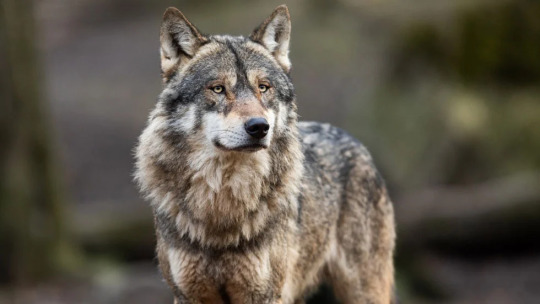
grey wolf, canis lupus
the grey wolf has already received an extensive TDF analysis, and overall serve as a general template to which to compare canis lupus subspecies. to point out several unique aspects of the grey wolf, it must be stated that the grey wolf tends to be one of the most social and group-oriented wolves. they have a strong focus on hierarchy and cooperation. they are also highly adaptable and even-tempered, capable of flexible behavior and adjusting strategies wherever they might end up. this makes them rather quietly bold and ambitious people; they are at ease out of their comfort zone, and they are dedicated to seeing their projects and intentions through. grey wolf daemians, in addition to the general wolf traits, are extroverted, confident, flexible, straightforward, and committed.
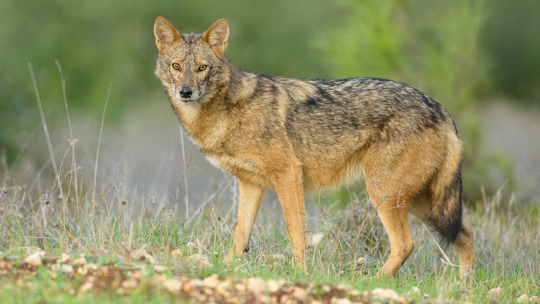
african wolf, canis lupaster
the african wolf, also called the golden wolf, is native to northern africa. it is a small wolf subspecies, intermediate between the jackal and the wolf, though its appearance changes based on its location: eastern african wolves tend to be small and more jackal-like, while northern and western african wolves tend to be larger and more wolf-like. despite this, they are genetic descendants of grey wolf and ethiopian wolf cross. african wolves live in small, flexible packs that fluctuate depending on prey availability. their social groups are demonstrative and affectionate; african wolves have frequently been observed grooming, playing, and courting. they are extraordinarily territorial and can be highly aggressive to intruders though interestingly are primarily reactive to intruders of the same sex. altogether, this paints a picture of an individual who's competitive and extroverted, gravitating towards like-minded companions but individualistic enough to head out on their own. their hunting habits are, indeed, varied; african wolves do take large prey, but overall value a generalist diet, employing multiple strategies such as turning over dung piles to find beetles. they will hunt more than they can consume and cache the prey until later — though they are highly territorial and hostile towards other scavengers. african wolf daemians, in addition to the general wolf traits, are adaptable, assertive, individualistic, socially savvy, and inventive.
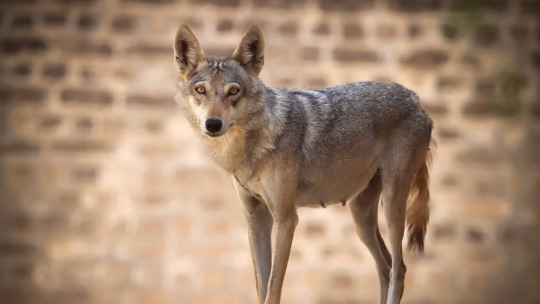
arabian wolf, canis lupus arabs
the arabian wolf is native to the arabian peninsula and lives in arid desert and mountain habitats. they are one of the smallest wolf subspecies, also notable for their large ears that help them disperse body heat. these wolves live in small groups and have an opportunistic, omnivorous diet. they tend to hunt alone or in small groups, though there is heavy competition for prey and they will readily rifle through human garbage. compared to grey wolves, arabian wolves are substantially less social. they only aggregate into larger groups during mating season or when prey is plentiful; otherwise, the arabian wolf is less territorial and not terribly communicative, and tends to be nomadic and always on the move. the arabian wolf soul is a perceptive survivalist, highly adaptable but prioritizes their flexibility to such a degree it makes them less likely to depend on others. they're more unobtrusive and self-focused, though they have the capability to be cooperative and are certainly tolerant of others. their competitive nature is essential to their form, however — it's a priority for them to have all of their needs accounted for, but their opportunism makes them highly resilient and they are excellent at completing projects even if it involves cutting corners. arabian wolf daemians, in addition to the general wolf traits, are going to be individualistic, self-motivated, flexible, not picky, and shrewd.

arctic wolf, canis lupus arctos
the arctic wolf is a grey wolf subspecies found in the high arctic tundra north of the treeline. these wolves are well-adapted for the snow and cold; they are a medium subspecies with small ears and possess a thick, typically white, double-layered coat. like the grey wolf, they live in packs and pursue large prey such as muskox and caribou. because their habitat is so isolated, they have very few natural predators (besides climate change) and tend to be rather confident and unafraid of people as a result. while arctic wolves are similar in sociability to the grey wolf, they are going to be overall more confident and specialized. these people are highly opportunistic and dogged when pursuing their goals, though they have a preference for depth over breadth. their ambition gives them resiliency and a self-assured nature. due to their tight ecosystem, these people will also be environmentally sensitive and perceptive — it is their preference that things are clear and they are in control, and they will endeavor to maintain stability in their relationships. these wolves also maintain extremely large territories often twice the size of grey wolf territories. an essential quality to this form is going to be how good they are at seeing the big picture, planning ahead, and ensuring their goals will be met. in addition to the general wolf traits, arctic wolf daemians are going to be specialized, confident, perceptive, resilient, and tenacious.

eastern wolf, canis lycaon
the eastern wolf is a subspecies found in eastern canada and is sometimes sub-divided into two subspecies: the great lakes wolf (larger, a higher percentage of grey wolf DNA) and the algonquin wolf (smaller, a higher percentage of coyote DNA). since they seem behaviorally similar, i'll be grouping them together. the eastern wolf is descended from a grey wolf/coyote hybrid similar to the red wolf; they are in between grey wolves and coyotes in size, and they live together in tight-knit packs. eastern wolves maintain rather small territories and primarily hunt deer, though their diet also consists of moose, elk, beavers, rodents, and berries. similar to grey wolves, they will often follow ungulate migrations and engage in food caching behavior. overall, the eastern wolf form is going to be fairly similar to the grey wolf. they are highly loyal and inventive, though a key distinction is that the eastern wolf is a degree more unobtrusive and conflict-avoidant than the grey wolf. they likely come across as more introverted and come to life around their loved ones. eastern wolves are also going to be somewhat more attached to routines and a sense of security, flexible when change is needed but not the type to take unnecessary risks. in addition to the general wolf traits, eastern wolf daemians are going to be dedicated, conflict-avoidant, supportive, cautious, and perceptive.
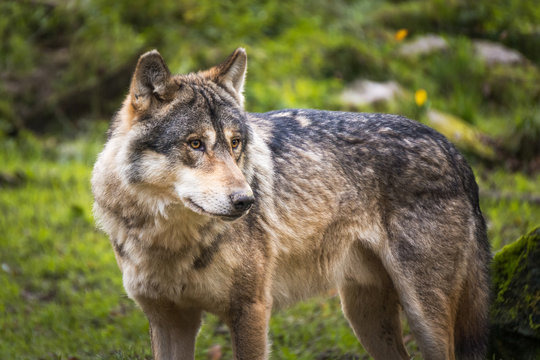
eurasian wolf, canis lupus lupus
the eurasian wolf, also called the common wolf, is native to europe and asia and can be distinguished from the grey wolf by their narrower snouts, shorter coats, and melodic howls. though the eurasian wolf has the largest range of all old world subspecies, they have lost a lot of their historical territory. their pack sizes tend to be smaller than grey wolves and they have an extremely varied diet — these wolves are often forced into populated areas and will subsist on livestock and human garbage. they tend to be less skittish around people than grey wolves as a result. similarly, they will often forage independently or in pairs as often as they will hunt in packs. their sociability is similar to grey wolves; eurasian wolf individuals will be similarly extroverted and tight-bonding, though can be distinguished by their survivalist and individualistic tendencies. they have a high degree of adaptability and can be inventive and risk-taking in their problem-solving. while loyal, they have confidence in themselves and their visions, willing to branch out in order to see things through. when compared to the grey wolf individual, the eurasian wolf soul can be distinguished by being more boldly adaptable, socially flexible, and ambitious, highly resilient to hardship. eurasian wolf daemians, in addition to the general wolf traits, are reliable, bold, adaptable, expressive, and quick-thinking.
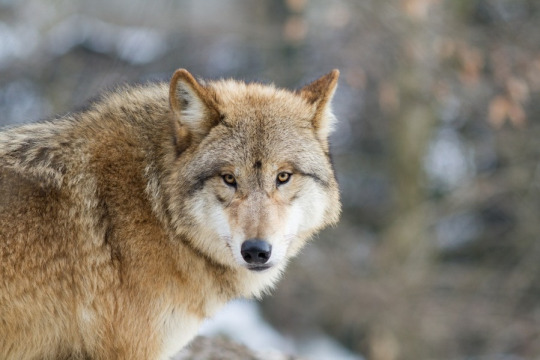
himalayan/tibetan wolf, canis lupus chanco
canis lupus chanco, called the himalayan wolf, tibetan wolf, and mongolian wolf, is found in the himalayas, tibetan plateau, and central asian highlands. this species is known for its thick and woolly coat which is typically fawn-colored to help it blend in among the steppes. they live in small packs and hunt both cooperatively and alone; prey include yaks, argali, kiang, antelope, and livestock. other notable aspects of the himalayan wolves is how they are biologically adapted for hypoxia and also have distinctly low and short howls. otherwise, this species closely resembles the grey wolf within its region. slight differences may exist in the himalayan wolf being more resilient and wary in nature, though overall they are still sociable and dependable individuals. likely due to their biome and their sparse distribution in the highlands, himalayan wolves also have a reputation of being less aggressive and territorial than grey wolves as well. these individuals are thus less assertive when their boundaries are crossed and would prefer to adapt their behavior or live and let live to avoid pointless conflict. in addition to the general wolf traits, himalayan wolf daemonians are going to be straightforward, perceptive, confident, tenacious, and tolerant.
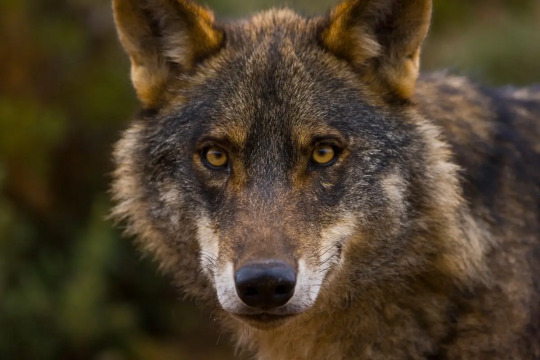
iberian wolf, canis lupus signatus
the iberian wolf is native to northwestern spain and portugal in relatively isolated populations that have resisted backcrossing or mixing with other wolf subspecies. these wolves are distinct for their slighter, small frame and the dark marks on their legs, upper lips, and tail (signatus for signed). it lives in small packs and its diet primarily consists of large ungulates such as deer, wild boar, and livestock, though like all wolves the iberian wolf is an opportunistic hunter and will also eat martens, feral cats, rabbits, and rodents. among its packs, the iberian wolf is hierarchical and a cooperative hunter; they have unique howls that are used for individual recognition and the dominant pair in the pack scent marks territory. while the iberian wolf is somewhat adaptable to their biome, they are reliant upon forest cover, and are known to be reclusive and rare even in their region. ultimately, this form embodies many aspects of the grey wolf in terms of expressiveness, group cohesion, and opportunism, but the iberian wolf will overall be more reserved and introverted. they are highly boundary-keeping and assertive — perhaps even wary at first, though natural problem-solvers who have a drive to succeed. their natural confidence makes them rather adamant and willing to take calculated risks similar to the grey wolf. iberian wolf daemians, in addition to the general wolf traits, are going to be introverted, opportunistic, perceptive, expressive, and protective.

indian wolf, canis lupus pallipes
the indian wolf is native to india as well as regions of southwest asia such as turkey and iran. overall indian wolves are small with short, thin fur and they live in open grasslands, thorn forests, and scrublands. while social, their packs are smaller than the grey wolf's, typically an average size of three and are widely dispersed across their habitat. interestingly, the indian wolf is a relatively less vocal species; they seem to rarely howl, though they have a wide repertoire of vocalizations including howling, "social squeaks", whimpers, and whines that they use to communicate with pack members. additionally, indian wolves tend to hunt small prey (such as rodents and rabbits) solitarily and larger prey (such as blackbuck and chinkara antelopes) in pairs, in which one indian wolf acts as a decoy. thus they've garnered a local reputation as extremely reclusive but clever animals — as is required, as the indian wolf has to compete with other local apex predators such as the tiger, dhole, and feral dog. the indian wolf individual is going to display some stark differences compared to the grey wolf, similar to other desert wolf subspecies. the first is that they're going to be much more individualistic, socially selective, and unobtrusive; indian wolves do not defend their territorials as strongly, and overall seem to prefer avoiding potential conflict. they're also going to be quick-thinking and highly cooperative, though even then somewhat reserved, perhaps slow to open up to others and wary about being the center of attention. in addition to the general wolf traits, indian wolf daemians are going to be introverted, observant, cunning, reserved, and conflict-avoidant.
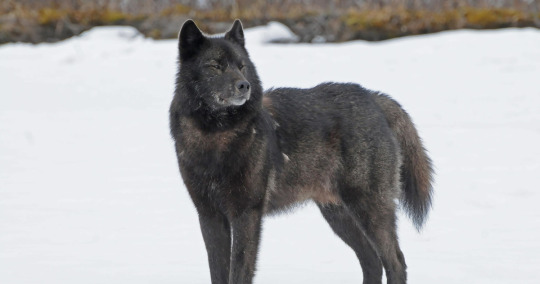
islands wolf, canis lupus ligoni
the islands wolf, commonly called the alexander archipelago wolf, is a subspecies found in a limited range in southeastern alaska along the coasts and islands. they are separated from the rest of north america by the coast mountains, creating a unique subpopulation that has resisted inbreeding with other wolf subspecies, coyotes, and dogs. the islands wolf is a small subspecies and is generally dark in color. they live in dense forests where they den in the roots of large trees and primarily hunt sitka deer, though will feed opportunistically on coastal species such as beaver, seals, salmon, birds, and marine invertebrates. their pack sizes can range between a pair or up to twelve members and the islands wolf is unique in that it does not disperse as much as other wolf subspecies and its home ranges are rather small. the islands wolf individual is thus going to show similar social tendencies as the grey wolf while being much more routine-oriented and less adaptable. this is one of the few wolf subspecies that is less opportunistic and highly dependent upon a single prey source; as such, the islands wolf soul tends to prioritize optimization and persistence when possible. they excel at exploiting opportunities though tend to be more sensitive when out of their comfort zone, as their preference is to stay with what is more dependable. it's also likely that they're socially flexible, comfortable in a variety of social situations and particularly cooperative and supportive when times become hard. islands wolf daemians, in addition to the general wolf traits, are dependable, routine-oriented, specialized, precise, and reserved.
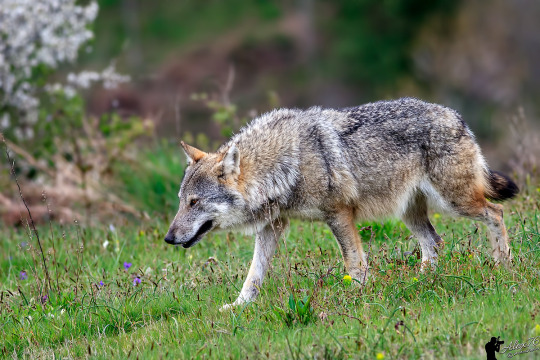
italian wolf, canis lupus italicus
the italian wolf is native to the mountain ranges of the italian peninsula, though it has modernly expanded northward into france and the french alps. these wolves are medium-sized and live in packs between two and seven members, though due to prey scarcity, they are most often found in packs consisting of a breeding pair and their adolescent offspring. they are opportunistic predators, feeding on medium-sized hoofed mammals like deer and boar, as well as smaller prey like rabbits, insects, and various fruits/berries. particularly in the summer, they are also voracious hunters of local livestock and will den near the edge of pastures on the mountain ridges. like most wolf subspecies, the italian wolf is also a cooperative hunter and highly social within its pack. similar to the grey wolf, they defend their territories and can be aggressive to intruders. overall, the italian wolf is going to be a similar form to the grey wolf particularly in terms of adaptability. they are confident, perceptive, and flexible, readily adapting or changing course when one avenue isn't working out. their sociability is somewhat more reserved than the grey wolf; they tend to be more private and protective, likely seen as reserved individuals who are tenacious when pursuing their goals or maintaining their boundaries. in addition to the general wolf traits, italian wolf daemonians are going to be dedicated, adaptable, tenacious, confident, and reserved.
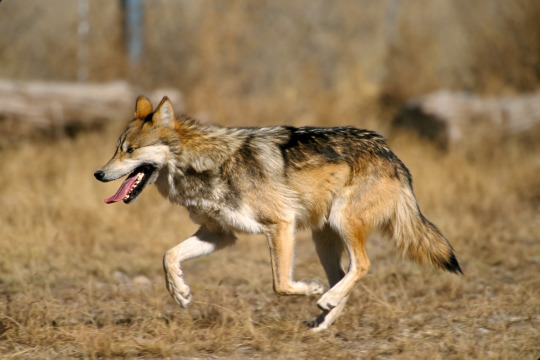
mexican wolf, canis lupus baileyi
the mexican wolf is a highly endangered subspecies endemic to northern mexico and the southwestern united states. the smallest north american wolf subspecies, the mexican wolf has long legs and a sleek physique. they live in mountain woodlands and deserts, maintaining large packs similar in size to grey wolves. their diet predominantly consists of elk, though they also will hunt deer, rabbits, and other small mammals, as well as scavenge carcasses and steal prey. these wolves are highly social and expressive; they have strong pack hierarchy and engage in play, vocalizations, and cooperative pup rearing. overall, the mexican wolf individual is going to be gregarious, supportive, and engaging. they are communicative and talkative, expressive and readily speaking their mind. like grey wolves, they're also going to be hierarchical and socially savvy, appreciating the dependability of a group and happy to cooperate to reach their aims. they're also somewhat individualistic like many wolf species, willing to hunt alone and will cache food away from the rest of the pack. despite their environmental sensitivity, mexican wolves are also going to be adaptable and inventive, similar to the grey wolf. mexican wolf daemians, in addition to the general wolf traits, are extroverted, vocal, flexible, energetic, and clever.

northern rocky mountain wolf, canis lupus irremotus
the northern rocky mountain wolf is a success story in conserving these subspecies populations. native to the rocky mountains and yellowstone, these wolves became critically endangered as settlers spread west, trapping and killing northern rocky mountain wolves that threatened livestock. massive efforts by the northern rocky mountain wolf recovery plan restored this population to the wild where they now live in idaho, wyoming, and montana. northern rocky mountain wolves are one of the largest grey wolf subspecies, typically bearing light-colored coats and primarily subsisting on large hoofed prey such as elk, bison, and deer. socially, they are similar to grey wolves; this subspecies lives in packs and will hunt communally as well as opportunistically. in terms of form viability, the northern rocky mountain wolf is analytically essentially identical to the grey wolf. one might consider this form if a somewhat more ambitious wolf appeals to them, with an emphasis on smooth cooperation and maximizing output. in addition to the general wolf traits, northern rocky mountain wolf daemonians are going to be cooperative, perceptive, confident, ambitious, and honest.

northwestern wolf, canis lupus occidentalis
the northwestern wolf is a very large subspecies native to the northwestern united states and southern canada. their bushy fur, size, and short legs help them thrive in the frigid northern mountains and forests. they live in packs of up to over 30 members and primarily hunt large animals such as moose, bison, elk, and caribou, as well as smaller grey like rodents, salmon, and rabbits. they are highly mobile and will travel for 10 hours a day, up to 70 miles to search for prey. their incredible hunting prowess has given them the reputation of being exceptionally intelligent, powerful, and cooperative. compared to the grey wolf form, the northwestern wolf is going to be a degree more reserved, tenacious within their comfort zone and inclined to work in a team. they are enduring and patient when it comes to their ambitions, not the type to shy away from hard work or cut corners if it means getting the best possible result. they're overall still expressive, tight-bonding, and devoted, more sensitive when away from their group. cunning and perceptive, this individual is quietly ambitious and loyal. in addition to the general wolf traits, northwestern wolf daemians are going to be strong-willed, observant, confident, gregarious, and tenacious.
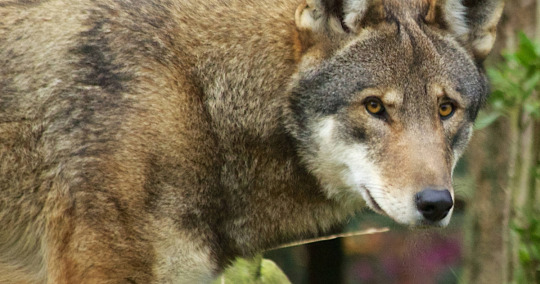
red wolf, canis rufus
the red wolf is a subspecies native to the southeastern united states, intermediate in size between the grey wolf and coyote and sometimes claimed to be a coywolf descendant. they are smaller and narrower than grey wolves and possess longer legs and ears. red wolves are historically habitat generalists, and while their range has been reduced significantly, they can still be found in swamps, forests, wetlands, mountains, and bushlands. they live in familial packs, typically consisting of a mated pair and their offspring, that assist in raising pups. overall, the red wolf is more sociable than the coyote but less social than the grey wolf; they hunt in groups or individually, playful with their pack members but highly antagonistic to strangers. they are omnivorous and generalist feeders, primarily eating deer, raccoons, rabbits, rodents, insects, and berries, as well as livestock. despite being highly endangered, red wolves are apex predators within their biome, though they are shy and secretive around humans. compared to the grey wolf, the most obvious distinction is that red wolf individual is going to be more boundary-keeping and private, willing to engage in conflict in order to maintain their peace. they're highly devoted and loyal to their people, but also value their sense of self and their own identity. they're socially savvy and tactful while also quite adamant. like the grey wolf, they're fairly adaptable and tend to be generalists, but tend to be more sensitive. in addition to the general wolf traits, red wolf daemians are going to be sociable, flexible, protective, cautious, and inventive.

sea wolf, canis lupus crassodon
the sea wolf, also called the vancouver coastal sea wolf, is native to the pacific northwest coast of north america. i included this subspecies because of their fascinatingly unique behavior. like many other wolf subspecies, they live in robust packs — however, they primarily feed on fish rather than hunt cooperatively. they will also forage on other marine wildlife such as seals, otters, barnacles, clams, and whale carcasses. often these wolves will forage alone, incredibly adapted for cracking open mollusks with their teeth. they are strong swimmers; they will migrate between islands on the archipelago, swimming between them and following the salmon migrations. sea wolves are notoriously reserved and rarely seen by people, though they're also powerful predators and have been known to fend off black and grizzly bears. their pack life is highly social and wolves spend most of their time together. when comparing interpretation of this form to the grey wolf, sea wolf individuals are going to be highly specialized and reserved, a unique person who seeks out like-minded companions. they are dedicated companions who are adaptable and inventive problem-solvers; these individuals are the sort who always come out on top, good at finding patterns and adjusting their behavior under challenges. they're socially flexible, both cooperative but possessing a dogged individual ambition. in addition to the general wolf traits, sea wolf daemians are going to be problem solvers, specialized, flexible, sensitive, and supportive.
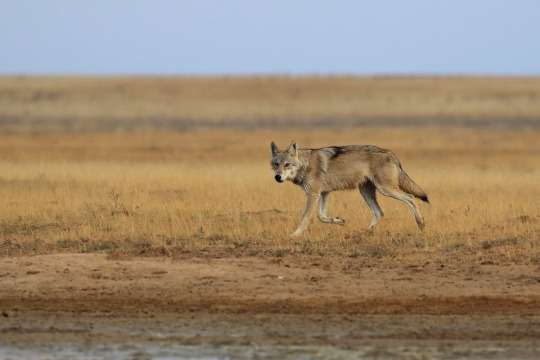
steppe wolf, canis lupus campestris
also called the caspian wolf, the steppe wolf is native to the caspian steppes and neighboring steppe regions. they appear similar to the eurasian wolf, though tend to be smaller on average, have shorter coats, and are characterized by their triangular face. these wolves are voracious hunters; they will hunt cooperatively and alone, preying on antelope, livestock, rabbits, rodents, and even caspian seals. while wolves are notable for taking large game and gorging themselves, steppe wolves have been reported to hunt more than they can consume. they also have an aggressive reputation; they live close to human settlements and pick off livestock, and they also appear to have higher than average rates of intra-pack antagonistic encounters. therefore the steppe wolf individual is going to be someone more bold and cutthroat than the average wolf daeman. they are ambitious and much less conflict-avoidant than other species, including the grey wolf, while still being highly hierarchical. this may indicate that they are sensitive to personal disrespect and disruption that affects group harmony. certainly populations of these wolves are brave enough to attack livestock in broad daylight. confidence is a key aspect of this form, perhaps to the point of arrogance in the name of making sure themselves and those they love are taken care of. steppe wolf daemians, in addition to the general wolf traits, are cunning, bold, adaptable, assertive, and achievement-focused.

tundra wolf, canis lupus albus
the tundra wolf is sometimes mistaken for the arctic wolf. while arctic wolves live in the northern arctic in regions of canada and greenland, the tundra wolf is native to the tundra of northern eurasia from finland to the kamchatka peninsula. they are of medium size and have thick, fluffy coats that are typically light in color. their diet fluctuates with the seasons; typically they hunt large ungulates such as reindeer, elk, bison, and muskox, though in the summer may also take birds and smaller prey. many aspects of this form is going to be similar to the arctic wolf: tundra wolves are going to be resilient, tenacious, and extremely specialized. this subspecies is heavily reliant upon the reindeer population that makes up most of their diet — their southern range is defined by the reindeer's migration. thus while this subspecies is still going to be cooperative, sociable, and tenacious, they're going to be less adaptable and more inclined to plan ahead in order to avoid obstacles. similarly, as they live almost exclusively in the far north or boreal forests, this subspecies is going to be more reserved and unobtrusive particularly compared to the arctic wolf. they have quiet confidence but may come across as aloof to those who aren't in their group of people. in addition to the general wolf traits, tundra wolf daemonians are going to be introverted, perceptive, specialized, tenacious, and conflict-avoidant.
68 notes
·
View notes
Note
Hey? You know that bird?? The one that is trans? The one on your blog, can you show me that bird again, or like pictures of examples of how birds change plumage and go from female to male? I cannot seem to find many pictures online :(
sure can!



image id: an eclectus parrot with a mostly green head, dappled with some red feathers, red feathers tipped with green on the neck, a half-plucked blue chest and abdomen, blue ventral wings, dark red wing feathers tipped with green, light eyes with wide dark pupils, and a black bill with the upper mandible streaked yellow and orange. there are some grey and white down feathers sticking out on her wings and chest from plucking. the other two images are pictures of the same bird, one a more zoomed out shot from a different angle, and one a close-up headshot. end id
the best pics of her i could find

image id: an eclectus parrot with a mostly red head, a green forehead and crown, a green chest dappled with blue, red patches underneath the wings, dark red wings with some green feathers, blue flight feathers, brown eyes, the upper mandible of the bill orange and yellow with a small streak of black, and a black lower bill mandible. end id
here’s another example of an eclectus parrot with marbled male/female plumage, his name’s atlas and he belongs to u/midgetcanadian iirc on reddit! this pic is from a long time ago actually, he’s gone fully green with regular male colouration and was dna tested to be male. he’s essentially the opposite case of the bird i work with, whereas she spent the first 15-odd years of her life with regular female colouration and started turning green after she bonded with an african grey we presumed to be male. that african grey has since passed away four-ish months ago, so we’ll see if his absence has any effect on her plumage.
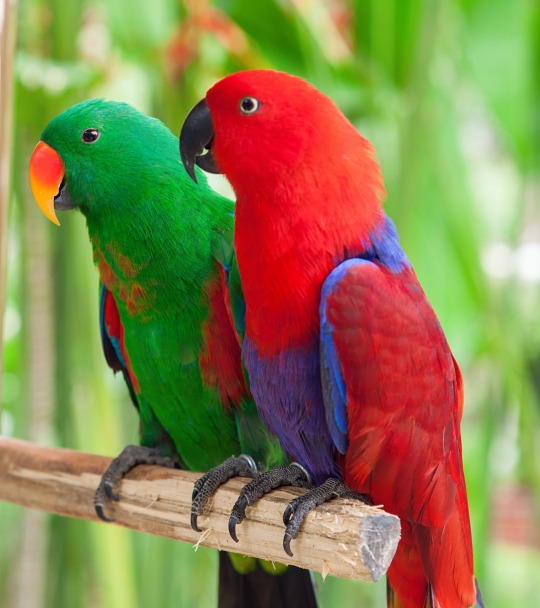
image id: two eclectus parrots, one male and one female. the male is mostly vibrant green, with patches of red under his wings, blue flight feathers, dark eyes, an orange and yellow top bill mandible and black lower mandible. the female has a bright red head and neck and darker red wings with a blue chest and body, blue on the ventral side of the wings, light eyes, and a fully black bill. end id
this is an example of regular male/female colouration (apart from the few red feathers on the male’s neck). they’re very distinguishable, so much so that ornithologists thought they were different species for years.
switching to different sexes like this actually isn’t unheard of in birds. sometimes, when a hen’s ovaries stop working for whatever reason, she will start behaving more like a cock, and if the species is sexually dimorphic, begin to appear like one, too. bird sex is a lot more fluid than human sex is as they have a completely different chromosomal system (Z and W chromosomes as opposed to humans’ X and Y), and birds can actually control the sex of their chicks if need be. zebra finches, for example, will begin producing more females if the flock is having a difficult time, and kookaburras always tend to hatch a male before a female.
it’s actually not super rare for female birds to suddenly “become” males when their sex organs stop working. this is especially common in domestic chickens, ducks, peafowl, but that’s likely just because it’s a lot easier to monitor them and take notice of when it’s happening. but why do birds never seem to change from males to females? it’s because, like how a humans’ default sex is female, all birds’ default sex is male. so it’s not like a bird has never been born intersex and had characteristics of both sexes/changed appearance from male to female over time, it’s just a lot more rare, since when a female’s defining female trait (ovaries) stops working, sometimes their bodies then default to male and a hen chicken would grow large, ornamental tail feathers, grow larger combs, and begin crowing. when a bird’s ovaries stop working, they stop producing oestrogen, and so they take on more male traits as a default. sometimes they develop testes as well, and there’s even been a case of a previously female bird siring viable offspring as a male. some birds have even been found to be gynandromorphic, where their secondary sex characteristics (plumage, flesh/beak colouration, fat distribution, etc) are split male/female neatly down the middle of their bodies.
so does this mean that millie (the first eclectus) is trans? yes and no, but mostly no. in a human sense, millie would not be trans, primarily because birds have no sense of gender. obviously this doesn’t mean she’s “cis” either; she just is. to call her trans would be gross anthropomorphism, which is ideally to be avoided at all costs when it comes to real life animals. however, as long as you’re aware that sex is a very complicated matter and that she’s not truly trans in the human understanding of it, i don’t see an issue with casually referring to millie and any other female-male birds as trans! we don’t fully understand what’s going on with millie in regards to her ovaries/testes and hormones, because as much as universities and labs want to study her, we don’t want to stress her more than is strictly necessary, and since her partner died, we won’t be handing her off to some scientist anytime soon. all we know is that millie is somewhere between male and female, and it’s not the rarest thing in the world that she seems to be switching from female to male. but in the case of atlas, the second eclectus above, his case was likely just a result of confused hormones while he was young, as he’s got entirely normal male characteristics now, and he was very young (1-2 years i believe) while he was marbled like that.
so yeah, bird sex is a very interesting thing to study and i am very lucky to have such a great example of sex switching in birds right at my own aviary!
(just as a side note: millie is unusual for two reasons! one is her sex switch, and the other is the fact that she bonded with an african grey like she did. parrots are very social animals and most of them form bonds for life, most parrots being monogamous and forming strong emotional bonds with their partners, african greys included, but eclectuses are the only exception to this. they are the only parrot species that isn’t monogamous; a female will mate with many different males over their lives, and males can tend to many different females at once. females will stay in their nest hollows for at least six months straight of the year, depending entirely on her many mates to bring her food, and males will spend all day every day bringing food to various females. millie was a strange outlier for bonding so closely to her mate, but very unfortunately he passed away from undetected cancer a few months ago. millie has been living with a volunteer since then as to reduce stress. you can partially see her mate standing on the same perch as her off to the side of the second pic.)
#got a little carried away here LMAO#anyways heres your infodump for today! bird sex is a super cool topic#also shoutout to ducks for being AGGRESSIVELY lesbian. this doesnt relate to the topic at all but i was reminded of it when i was doing#research for this and it’s just really funny to me. good for them#asks#birds#bird#birdblr#birblr#parrots#parrotblr#biology#infodump#long post#animal death#100
155 notes
·
View notes
Text
yandere!mark beaks x reader hcs
notes: stalking, possessive behaviour, implied kidnapping
If there is anything Mark picked up from among the rubble of his parents’ failed marriage, it is that he would like to do it all better. Not only to rub it in his mom’s face after years of being told he’d have to change (though he’ll have to record the moment he breaks it to her), but to prove once and for all that he’s not like her. And not like his dad, either. He’ll be loving, or whatever!! A good partner. …Sure, he’s not thought much about the details yet, but it’s best if that kinda stuff comes naturally, right?
Though the idea sticks in the back of his mind, Mark doesn’t try to find anyone he’s compatible with. He doesn’t use any dating apps or goes on dates at all, for that matter, and is famously bad at picking up on flirting. People have certainly tried. No one has caught his eye, and so he doesn’t care all that much. He fully expects life to throw the perfect person, the one who will unconditionally love him, right at his feet– No effort involved. Easy peasy. As an African Grey Parrot, the idea of bonding intensely to one person is instinctively already appealing to him, only bolstered by his personal opinions. He can’t just go around having failed relationships with people, it needs to be a one hit K.O. Otherwise, the point he’s making wouldn’t count.
His feelings for you hit him like a flash of lightning. It’s love at first sight, he believes, and he’s immediately all over you, taking so many selfies that the shutter makes a continuous noise. Your first conversation is likely a rushed one with little substance, Mark feeling so euphoric in that moment that he isn’t really listening to what you’re saying. But he has your face and your first name, which is all he needs.
He spends hours finding and sifting through all your social media, including accounts you haven’t used in years. Every picture he finds of you is saved instantly, and he jots down the names of everyone he sees you interacting with frequently. Most importantly, he looks at your interests, likes and dislikes, and what kind of person you present yourself as online. He’s spent enough time online to know that people often either idealised self, in one way or another, and he’s sure he could get you whatever you want.
He could figure out all of these things through actually talking to you, of course, but that’d take far, far too long. That’s for commoners. He’s simply making the way to your heart easier and more enjoyable for the both of you! Efficiency is how he got his success, that’s all there is to it. Mark’s attention span makes it so that he can’t spend long focusing on most tasks, but he physically can’t get bored of finding out more about you.
Once he believes he knows what kind of person you are, the texts and calls begin. They’re constant. In between listening to music and making posts, he’s sending you personal updates on his every thought and conversation. He’ll call you in the middle of conversations or meetings when he’s not interested in whatever the other person is saying, and talk and talk and talk. Whether you pick up or not. Your voicemail box fills up very quickly. No matter how many times you change your number, he’ll figure it out again. Whenever you block him, he simply pulls out a new phone. You can’t block his account on Waddle, and his face is often plastered all over your feed with how often he posts.
You’re getting a copy of each and every new piece of Waddle tech, personally customised to your taste as well! It’s better to toss them in the corner or simply get a burner phone, as the vast majority is equipped with both tracking software, plus a constant livestream to Mark’s phone. Not to mention, a phone through which you can only call him is not the most convenient thing in the world. You get far more gifts from him, though. He wants to indulge in every sickeningly sweet couple trend (whether you’re dating or not), and you get heaps of matching clothes. Somehow, everything you’ve looked up to purchase ends up at your home the next day as well.
He gets jealous incredibly easily, and his reactions are always overblown. You like one of your friends’ posts, but not his, even though it’s been up for longer? That’s enough to set him off and prompt even more calls. When you’re spotted hanging out with anyone else, it’s even worse. Mark doesn’t like getting anywhere near physical fights, so he’ll simply start online smear campaigns against whoever you’re hanging out with. He either digs up old information on them, or simply fabricates whatever he wants to make sure their reputation is entirely ruined. If that doesn’t stop you from spending time with them, well… He has enough money to make someone permanently disappear.
If you notice any tension between him and your friends and try to reconcile instead of barring either of them from your lifes, good luck. Mark will be purposefully obnoxious, only responding when you speak to him and constantly blasting music from his phone. He’ll call you out online for ‘forcing him to spend time with someone who he hates’, and tags you a million times. His only intention with this is to make you feel guilty. Once he takes note of some of his fans sending you terrible messages, their accounts will be suspended and their IPs banned. It’s only a rightful suspension for harassment. But he only does this after first ratioing them.
Mark simply can’t fathom the idea that you wouldn’t want to be together with him. He’s clearly the best person you know, right? And he’s done so much for you. He thinks just giving you some fun tours, forcefully inserting himself into your daily life and a constant barrage of gifts is enough for you to absolutely adore him. Your personal feelings on this are simply not taken into the equation. As such, anything other than outright telling him you want nothing to do with him flies right over his head. Even then, he believes you’ll come around with some time and extra attention.
If you continue to deny him directly enough for him to understand, he’ll get increasingly anxious and desperate. It starts off with just fishing for more compliments in conversation than usual, and noticeably puffing up his feathers when you eventually relent to his bombarding. If things get bad enough however, he’ll actively start plucking at and pulling out some of his feathers while thinking the situation over. Your relationship has become a very big deal to him, and he might have already told his entire family that you’re getting married soon.
Mark is far from impossible to manipulate. When it’s coming from you, at least. A constant drip of attention and praise is, generally, enough to keep him placated. (That’s all he really wanted, in the end. Someone who looked at him and wouldn’t want to change him, someone who didn’t ridicule him or criticised him but loved him no matter what.) He yearns for your attention enough that he doesn’t really think about the possibility of it being fake. It’s a delicate balancing act though and, no matter how hard you try, the ending will remain the same: Though at a private wedding you are granted his last name, your whole identity will forever be wiped off of any remaining records.
73 notes
·
View notes
Note
I would like to ask if you think there is an equivalent of Parseltongue for other animals. I would like to ask if you think there is an equivalent of Parseltongue for other animals. Like, is there any wizard who can talk to birds, cats, dogs, fish, amphibians, mammalians and other types of animals?
Parseldrakon
If you want to come up with other ones, I suppose you could, but that would remove the uniqueness of Parseltongue, cause way more ethical problems, and also raise the question of why no one knows about or acts on this. Even if it's as rare as Parseltongue is, people would still know it exists and have opinions on it.
There's also that while some other animal-speech abilities have been headcanoned - such as @americanwizarding's Bird-Kissed - they often run on fanon ideas of Parseltongue in order to contrast them, in ways that just don't work so well? Despite what that post says, Parseltongue can just be learned, no dark magic or ceremonies required, and there is no binding geas on magical serpents to respond to or obey a parselmouth.
And as mentioned above, the ethical problems: if people can speak to these much more commonplace animals, such as birds - the wizarding world makes huge use of owl-post, what happens when people can talk to the owls? Such an ability would be heavily regulated to prevent interference with the post, and the skill might also be a sure-fire invitation to work in the national post system or for the more espionage-oriented organisations. What happens to your chickens for eggs and roasting? Your geese for eiderdown? Your turkeys for Christmas or Thanksgiving? This significantly worsens the ethics of things like keeping parrots, especially long-lived African Greys, if they're sapient. And if these animals are sapient, what crime is the magical community allowing to continue by allowing the exotic bird trade or zoos?
An important question to ask when worldbuilding isn't just "is this idea cool" or "can I do it" it's also "what are the consequences of doing this?"
Parseldrakon, as I headcanon it, means people who can speak Parseltongue can learn a dialect that allows them some limited communication with dragons - it's rare, limited, and linked to a trait believed Dark, which explains why it's less common knowledge because Parselmouths would hide it. Why would they say "Oh yes, I can talk to your dragons and maybe calm them down for medical check-ups" if it means they might also get charged of dragon taming or poaching, of commanding dragon escapes and attacks, and be attacked for it?
So - what happens when people can talk to amphibians? Toads, frogs and newts are all potions ingredients. How do you deal with the ethics of that? Cats and dogs might be more possible, but if you're aiming for talking to your domestic pets, why not just find a way to headcanon "familiar bonds" in a way that doesn't breach canon? Birds, I've already mentioned. Fish - merfolk might be able to talk to some, but why or how would a human ever learn to, and why would merfolk try to talk to food?
It is important to at least be willing to ask "why not" as well as "how can I", because yes it can be a bit of a bummer, but it also means your idea holds up more securely to scrutiny.
28 notes
·
View notes
Note
I’m not sure if this had already been asked but if the guys were willing to adopt a bird as a pet with MC, what kind of bird would they prefer? And how would they react around the birb? 👀
Alexei - African Grey Parrot. He'd take excellent care of it, and would spend a lot of time teaching it words and such.
Brooklyn - Macaw. He would enjoy creating a habitat for it inside his mansion. I could also see him with canaries.
Leo - Budgie(s). They are bffs.
Milo - Green-cheeked conure. Takes the time to bond. A good bird dad.
Rory - Lovebirds. Remember this for the full game. He's very soft for the birbs.
Tobias - Cockatoo. Spends a lot of time with it. Would probably teach it bad words.
40 notes
·
View notes
Text
Who is the Most Talkative Bird

Parrots are known for their remarkable ability to mimic human speech, but one species stands out as the most talkative: the African Grey. This article delves into the fascinating world of the African Grey parrot, exploring its features, characteristics, and the reasons behind its reputation as the most talkative bird.
Who is the Most Talkative Bird?
The title of the most talkative bird is held by the African Grey parrot. Native to the dense forests of central and western Africa, these birds have gained immense popularity worldwide due to their exceptional vocal abilities and intelligence.
Two main subspecies are recognized: the Congo African Grey and the Timneh African Grey, both of which are noted for their speech and sound mimicry.
Features and Characteristics
Here are some features and characteristics of african grey parrot.
Physical Description
African Greys are medium-sized parrots with a predominantly grey plumage. The Congo African Grey typically has a bright red tail, while the Timneh variety sports a darker, maroon tail. They have a strong, curved black beak and are roughly 12 to 14 inches in length.
Cognitive Abilities
These parrots are not just talkative; they are also incredibly smart. African Greys have shown cognitive abilities comparable to those of young children in certain aspects. They can solve puzzles, understand concepts like bigger/smaller, and even grasp some aspects of causality and time.
Vocal Abilities
African Greys are known for their wide range of vocalizations, including whistles, squawks, and most impressively, human speech. They can learn an extensive vocabulary, often using words contextually correct. Some African Greys have been known to learn hundreds of words and sounds, showcasing their unparalleled mimicry skills.
Social Behavior
In the wild, these parrots are social creatures, living in flocks. They form strong bonds with their mates and are known to be quite affectionate and playful. In captivity, they require a lot of social interaction and mental stimulation to stay happy and healthy.
Do I Need to Train African Grey Bird to Talk?
Training an African Grey parrot to talk is often a rewarding process, both for the bird and its owner. While these parrots are naturally inclined to mimic sounds and speech, effective training can significantly enhance their ability to talk and use words appropriately. Here are some key points to consider when training an African Grey to talk:
Start Early
The best time to start training is when the bird is young. Young parrots are more receptive to learning new sounds and words.
Regular Interaction
Frequent and consistent interaction is crucial. Talk to your parrot regularly, as they learn by listening and then mimicking the sounds they hear.

Clear and Repetitive Speech
When teaching new words, speak clearly and repetitively. Parrots learn through repetition, so consistently using the same words or phrases will help them pick up on these quicker.
Positive Reinforcement
Use positive reinforcement techniques. Reward your parrot with treats, praise, or affection when it successfully mimics words or sounds. This reinforcement encourages them to repeat the behavior.
Create a Conducive Environment
Ensure your parrot's environment is conducive to learning. A stress-free environment with minimal distractions aids in better concentration and learning for the bird.
Social Interaction
These birds are social creatures, and they learn faster in an interactive environment. Regular social interaction can stimulate their learning process.
Patience and Consistency
Be patient and consistent in your training. Some birds may take longer to start talking, and their ability to learn words varies.
Variety of Words and Sounds
Expose your parrot to a variety of words and sounds. This can include everyday conversations, music, and even watching television with them.
Remember, while most African Grey parrots have the capacity to develop impressive verbal abilities, each bird is unique. Some may naturally be more inclined to talk than others. The key is to create a nurturing and stimulating environment that encourages them to use and develop their vocal skills.
Why It Is Considered the Best Talkative Bird?
Here are some reasons:
Clarity of Speech
The African Grey's ability to mimic human speech is not just about the number of words they can learn; it's also about the clarity with which they speak. They can replicate the tone and pitch of human voice remarkably well, making them sound almost like a human speaker.
Contextual Understanding
Unlike many other parrots that mimic speech, African Greys often show an understanding of the context in which words are used. This ability to use words appropriately in context sets them apart from other talking birds.
Emotional Connection
These parrots are highly sensitive to their owner's emotions and can sometimes use their vocal abilities to respond to these emotions. This emotional connection they establish with humans is a significant factor in their ability to communicate effectively.
Longevity and Learning
African Greys have a long lifespan, often living up to 50 years or more in captivity. This longevity gives them ample time to learn and refine their language skills, making them more proficient speakers as they age.
Conclusion
The African Grey parrot's combination of clear speech, contextual understanding, emotional intelligence, and a long lifespan make it the most talkative and arguably the most intelligent of the parrot species. Their remarkable abilities extend beyond mere mimicry, reflecting a deeper cognitive prowess that continues to fascinate and delight bird enthusiasts and pet owners worldwide.
FAQs
What bird is the best at talking?
The African Grey parrot is widely considered the best at talking. Known for their ability to mimic human speech with remarkable clarity and intelligence, they excel in both vocabulary and understanding.
What is the best talking bird to own?
The best talking bird to own largely depends on the owner's lifestyle and experience with birds. African Greys are excellent for their talking ability, but they require significant social interaction and mental stimulation. Budgerigars (budgies) are a good choice for beginners, being smaller, easier to care for, and also capable of learning a variety of words.
Which bird is considered the best talker?
The African Grey parrot is generally considered the best talker. They are not only adept at mimicking human speech but often understand and use words contextually, showing a high level of cognitive ability.
Which is the intelligent talkative bird?
African Grey are not only talkative but also highly intelligent. They can understand and use language contextually, solve complex problems, and are known to have a level of intelligence comparable to that of a young child.
What is the 2 loudest bird in the world?
The two loudest birds in the world are the White Bellbird, which holds the record for the loudest call of any bird, and the Kakapo, a type of parrot known for its very loud, booming mating calls. These birds are renowned for their volume rather than their ability to mimic speech.
Read the full article
3 notes
·
View notes
Text
#african grey#tiktokparrot#african grey lifespan#african grey parrot care#african grey behavior#buying an african grey parrot#africangrey#african grey parrot lifespan in captivity#african grey parrot#cute birds#african grey adoption#African Grey anxiety#African Grey as a pet#African Grey beak trim#african grey biting#African grey body language#african grey bonding#african grey care#African Grey clipped flight#African Grey clipping guide#african grey enrichment#African Grey escape prevention#African Grey flight#african grey food#African grey Habitat#african grey life#African grey lifespan#african grey Molting#African Grey Parrot#african grey parrot clipped wings
0 notes
Text
A small tip of perspective for those that struggle to navigate their own needs but are animal lovers / pet parents, try to approach yourself and your needs (and for systems, parts and system needs) as if you were trying to understand a specific needs profile of a breed / version of the pet aren't the most aware of and don't have the ability to look up. I don't know how well this applies to non-dog/bird species, but largely in birds and dogs, there is a large variety of needs depending on the species / breed you get and even within species and breeds. What one needs is going to be drastically different from the other
What sort of enrichment is necessary to make this animal happy and able to live to the most of their natural behavioral capabilities? What sort of social exposure and activity does this animal need to meet their needs and make sure they have an enriched life? What have they been eating? Has it been one same meal over and over again beyond the point of enjoying it still? When was the last time things were changed up? When was the last time they were bathed or given the opportunity to see something new?
Largely our system is a bird, and like any bird, you really can't keep them in a cage all day so we have system rules that we should try to leave the house every day for at least an hour and preferably go somewhere that has something to look at that we haven't done in a while. We call this the "Fly the Coop" time and its just a general welfare rule. Treat the bird in our brain like the bird it is and give it it's "outside time" because not giving a bird that would be very bad for them.
We also are a parrot to be specific so it is very important to give us something to work on, a puzzle to figure out, and active mental stimuli and enrichment. We have a very high curious and drive to learn and figure things out, so like any particularly curious parrot, its important to lay out a number of activities, problems, and puzzles for us to figure out and build on - as a result it is important for us to always have a list of skills and problem solving and creation related things availible for us to engage with.
We are also very social but we aren't so much the active cuddler (save for specific parts) and active affectionate type, so much as we are more around the ways of an African Grey or Cockatiel that needs passive company and benefits from a mutually engaged environment; so it is important to have people (or birds for our case as it fills the need) around us doing their own thing and even better if they are also engaged as it lets us relax in an engaged state. Mutual engagement is one of the solid bonding activities. Additionally, we fill our social needs often in the form of social bathing, social eating, and general social cleaning / preening, so when possible, its good to put ourselves in environments where others are doing similar and/or bring our close people and our birds into those activities with us.
Routine is highly important to us as well which again is a good parallel to parrots so we keep that in mind.
With the general frame work, we can really easily apply a mental check list / needs list by largely applying a "welfare and needs" marker for a "non-existant parrot" and apply that to ourselves so rather than trying to figure out what "We Need", we can just make sure we have made sure the parrot need profile in our head has been met.
Largely following the general caresheet for the specific type of parrot that we are has honestly led to a lot better self care and day to day management of our mental, psychological, and physical health so its a perspective thing I do recommend.
11 notes
·
View notes
Text
Oc Introduction: Graham Alden ✣

Name: Graham Alden
Age: 21
Birthdate: February 14th, 1956 Aquarius 🏺
Gender: Non-binary, They/Them
Orientation: Achillean (Attraction to non-women, meaning: men loving men, non-women loving non-women, and non-women loving men)
Species: Poltergeist
Appearance
Height: 6'0"
Eye Color: Full golden yellow scalera, no iris or pupil
Hair: Wears hair naturally with 3c curls, hair is to their shoulders, has bangs that cover their eyes, hair is a blue-grey
Race: African-American
Body description: Rectanglular, lean and broad with thinly defined muscles along the arms, pretty flat everywhere
Body extras: Upon waking up as a spirit, their skin turned into a luminescent baby blue that changes color depending on their emotions (yellow=happy, bashful/flustered=pink, etc.), Has permanent bruising and cuts around their neck from their death, has a gap in their front teeth
Style: Classic and bright 70s, open and sharp collars and flared pants, prefers to wear warm colors, loves patterns and showing off their legs, wears a peachy ascot around their neck to cover up the old scars, loves wearing novelty shades like ones shaped like stars, hearts, etc
Personality
Optimistic, Pretty Mischievous (they love to tease others and get under their skin), Emotional, Protective of loved ones, Carefree but usually prepares for worst case scenerios
Occupation: Works as a general aid and audio technician for CRPT 64.7 Radio Station. They help prepare others for their broadcasts and makes sure all the audio runs smoothly
Backstory:
- Their death date is February 14, 1977, their 21st birthday
- They got hit by a drunk driver and broke their neck
- Graham never liked how quick their life ended, their anger and refusal to cross over transformed them into a poltergeist
- Owner of CRPT Radio Station, Johnny Greyson found Graham haunting the studio, distorting their audio with their own laughter and mockery, and quickly took them in
- They lived under one of those "work to stay" agreements, but they grew to adore their job and they have a close bond with Johnny
Fun Facts:
- When they were alive they used to help run a record store, and by night they would DJ for a lot of underground parties
- Their favorite band is Redbone
- They constantly wear a fannypack with all sorts of items they found
- From thread and bandaids to rocks and shiny pennies, Graham has built a little collection of trinkets they carry with them
Johnny belongs to @the-pinstriped-hood ♡ thank you for helping me develop Graham!
Tagging: @rottent33th, @slaasherslut
15 notes
·
View notes
Text
CONFIRMED ANIMALS FOR THE ANIMAL EXPERIMENTS!
-Moray eel
The great Clem ESCAPE
-A tabby cat
-A doe
Meri bonding time
-African Grey parrot
-A greyhound
-A guinea pig
-pig
-corn snake
There’s not too much left to do am very excited!
6 notes
·
View notes
Text

7567 tears to fill an ocean...
The most interesting thing about me isn't even me. It is the tiny tyrannical terrors that rule my life—my African Grey Parrots, Frankie and Harley. I am 21+.
♔ To catch my attention...
&—; Parrots, namely African Greys
&—; Clone Troopers: Rex, Wolffe, and their army of vod'e.
&—; Jedi: Anakin & Obi-Wan
&—; Kaminoans (species)
&—; Ships: ❤ Anakin/Rex (Rexwalker) ❤ & ❤ Obi-Wan/Rex (ObiRex) ❤
♔ — NAVIGATION
For sanity's sake...
&—; FAV ❤ Characters: REX, Wolffe, Obi-Wan, Anakin, Plo (more to come)
&—; Characters: Cody, Fox, Fives, Fordo, Boba, Ahsoka, (...)
&—; True ❤ Ships: Anakin/Rex (Rexwalker) & Obi-Wan/Rex (ObiRex)
&—; Other Ships: Thorniyo
&—; My Parrots / My Birds / Birbs
&—; Star Wars: References, Meta
&—; Miniature people—I collect 1/6th scale figures. Mostly Clones.
&—; Gifts received.
&—; References (another post)
&—; Kilt's Other Interests (may add another post.)
&—; Kilt's Brain—useless thoughts
&—; Kilt's World—ly things. Overlaps with the brain.
&—; Kilt's Birbs—Live with dinosaurs they said; it'd be great, they said.

♔ Creative banality—
Mostly, I write headcanons, meta, snippets, and work on fanfics. I have the special talent of starting off hilarious and full of fun, then somehow everything I do take a left-turn to a forest of angst.
&—; Headcanons—more SW Clones.
&—; Clonely Headcanons—Clone headcanons.
&—; SW Meta—yep.
&—; Clonely Meta—Just for Clones.
&—; Snippets—Little ficlets and things.
&—; Fics—Little ficlets and things.
&—; Writing—Headcanons, snippets, Meta, Fics... kind of catch-all.
♔ AUs—
&—; AU: Little Troopers—[oldest]—the Clones get de-aged.
&—; AU: Bonded—Two halves, one heart—[oldest]—Clones and Jedi are bonded.
&—; AU: Chosen Dancer—[oldest]—Princess Tutu inspired. Ballet, music, fairytales...
&—; AU: ARCFormers—[oldest]—ARCs are magicked to be capable of transforming into animals.
&—; AU: Modern Academics—[oldest]—self-titled AU where Rex is an educator, but so is Obi-Wan, and Anakin. Who knows who else?
&—; AU: Batakin Skywalker—[oldest]—Anakin Skywalker is a humanoid bat.
&—; AU: Shattered Mirror—[oldest]—What if the Heroes and Villains swapped roles? Based on art.

♔ "Stay calm, what's the procedure!?"
Tags/Triggers/Squicks:
(Rules, Guide, Requests)
In general, I try to make as little demands as possible on others.
Tags:
&—; TAG ALL SHIPS (e.g. #Obirex and #Rexwalker)
— Q: "Why is this important?"
— A: This allows for content to be filtered or browsed.
&—; Tryp*phobia (small holes, etc.)
&—; Major Character Death
&—; Bad Batch Season 2
&—; Content Warning Tags:
Overall, I do not tag for many cw warnings, aside from ships or discourse, not unless asked.
(I still retain the right to politely decline.)
These are the cw tags I do use:
— #cw deep sea; for sea creatures. Will be used for visual mediums, only.
— #cw shell mollusks (shelled squishy things.)
— #cw trypophobia: sea things do this a lot, or there is something that itches this phobia—OR—I know that if I wasn’t expecting it, it would bother me or worse... trigger me. Funfact, did you know that trypophobia is a spectrum?
&—; Mutual Breaking
— If I am mutual with someone and it is broken on the other side, I take that as a boundary to cut off communication. So, I will unfollow, block, and keep my distance on tumblr and elsewhere—including Discord. This may seem extreme and maybe it is. But I don't want to live guessing if someone doesn't want to retain contact with me. There are too many guessing games on the internet.

&—; Critical Content:
Any content written that may come-off as critical of fandom interests will be tagged #[subject] critical.E.g. #rexwalker critical.
NOTE: I tend to be overly zealous and cautious about this. So, even if I am simply stating that I do not ship something, I will tag it as critical.
♔ — EXTRAS
I do ROLEPLAY for those interested...
— Captain Rex, can double-up or trade for ships.
— 3rd person. Novella/Literate
— Discord 1x1, maybe groups.
— DM for more.

♔ — Fandom Spouses:
What is a fandom spouse? This is a partner in crime, a buddy of banality, a blorbo consultant; someone who talks at length about their beloved character, and listens to me in kind. They are a great resource for me to turn to if I have questions about said character or the meta the focuses on them. They are often a fandom best friends, though rarely the only one. There may be others in private spaces that fit this role, but they may have a much more private presence online.
— Obi-Wan @ninjigma (Obi-Wan, and over-all Jedi greatness.)
— Anakin @spacingstars (Anakin, Anakin, Anakin, Anakin.)

29 notes
·
View notes
Text
I just have a lot of feelings about Misty choosing an African Grey parrot as a pet.
They’re extremely intelligent creatures. They can hold simple conversations that go beyond pure mimicry. They’re incredibly emotionally complex, and very needy, requiring a level of dedicated care that many first-time owners aren’t prepared for - they will quite literally go insane if they aren’t given enough attention. They bond intensely with their owners. They’re ridiculously long-lived in captivity, with an average lifespan of 60+ years.
And yet they’re still pets. It’s considered not only acceptable, but desirable to keep them under your close supervision, to have a cage you can put them in when you need to, to make decisions about their lives for them, and to not give them the opportunity to escape the controlled environment you’ve created for them.
In short, Misty chose a pet that is arguably as close as possible to her idea of an ideal long-term human companion - and because it’s a pet, she can ensure that it will never, ever leave her.
38 notes
·
View notes